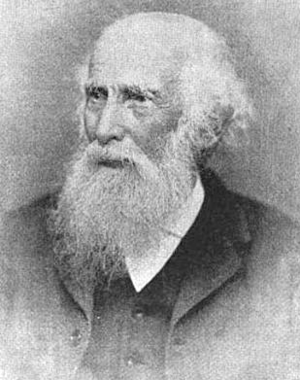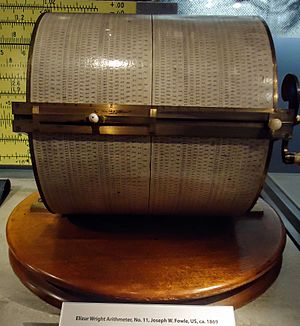Elizur Wright facts for kids
Quick facts for kids
Elizur Wright
|
|
|---|---|

Wright in 1883
|
|
| Born |
Elizur Wright III
February 12, 1804 |
| Died | November 22, 1885 (aged 81) |
| Education | Yale College |
| Occupation | |
| Known for | Advancements in life insurance and its regulation |
| Signature | |
Elizur Wright III (born February 12, 1804 – died November 22, 1885) was an American mathematician and abolitionist. An abolitionist was someone who worked to end slavery. He is often called "the father of life insurance" or "the father of insurance regulation" in the United States. This is because he fought for rules that made life insurance companies keep enough money (reserves) and pay back policyholders who wanted to cancel their plans (surrender values). Wright also worked as an insurance commissioner for the state of Massachusetts.
Contents
Elizur Wright's Early Life
Wright was born in South Canaan, Connecticut. He grew up in a very religious Christian family. They believed strongly that slavery was wrong. This taught him to have a very strong sense of right and wrong.
Elizur was one of ten children. His father, also named Elizur Wright, was a smart mathematician. He had graduated from Yale College. In 1810, Elizur's family moved to Tallmadge, Ohio. There, young Elizur helped on the family farm. He also went to an academy run by his father. The famous abolitionist John Brown was one of his classmates. The Wright family home often gave shelter to enslaved people who had escaped.
College and Early Teaching Career
In 1826, Wright graduated from Yale. He then started teaching. First, he taught for two years in Groton, Massachusetts. There, he met and married Susan Clark. Later, he taught math and science at Western Reserve College in Hudson, Ohio. This was the first college in northern Ohio.
During this time, Wright read the writings of William Lloyd Garrison. Garrison's book, Thoughts on African Colonization, convinced Wright that slavery should be ended right away. He also believed that sending free Black people to Africa was wrong and not practical.
Garrison's ideas also influenced Western Reserve College. In 1832, a professor named Beriah Green gave strong anti-slavery sermons. This caused a big stir and led to Green leaving the college. He went on to lead the Oneida Institute. This school focused on training future abolitionists.
Fighting for Abolition
In December 1833, Wright helped start the American Anti-Slavery Society. This happened at a meeting in Philadelphia. He moved to New York City that same year. Wright became the national secretary for the group for five years. The Society wanted to end slavery immediately. They also called for an end to racism and for equal rights for everyone. To achieve this, they tried to convince people that slavery was wrong by appealing to their ethics. This was called "moral suasion."
Wright edited many publications. These included Human Rights and The Emancipator. Because he spoke out against slavery, some people who supported slavery became his enemies. His house was once surrounded by an angry crowd. There was even an attempt to kidnap him.
In 1838, he moved to Boston. There, he became the editor of the Massachusetts Abolitionist. He later started his own newspaper, the Chronotype.
The Great Postal Campaign and Political Action
Wright was also involved in "The Great Postal Campaign." This project sent anti-slavery materials all over the country. The Anti-Slavery Society successfully found people across the nation to spread their message. However, some members, like William Lloyd Garrison, started to include women's rights in their goals. They also took on an anti-religion and anti-government stance. Wright and others disagreed with this. They began to separate from the Society in 1840.
Wright then joined the Liberty Party. He started to believe that government action was the best way to end slavery. Wright was part of the Boston Vigilance Committee. This group helped enslaved people who had escaped. He was arrested for helping Shadrach Minkins escape in 1851. Minkins was the first Black man caught in New England under the Fugitive Slave Act. Wright was not found guilty.
Over time, Wright became less involved with the abolitionist movement. He was also disappointed that his church did not support the anti-slavery cause enough. He began to look for non-religious ways to solve social problems. Eventually, Wright, who was once very religious, became an atheist.
Elizur Wright's Inventions
Between 1853 and 1858, Wright worked on inventions. He created a machine for making spikes. He also designed a new water faucet and an improved pipe connection. He received patents for the last two inventions. He even made them for a short time.
Improving Life Insurance
Elizur Wright became very interested in life insurance as a mathematical subject. He studied the best books on the topic with great passion.
In 1852, an insurance broker gave him an advertising booklet. Wright quickly saw that the company could not do what it promised and still stay in business. When he was 40, Wright visited the Royal Exchange in London. He wanted to learn more about the life insurance industry. There, he saw an advertisement. It was for the sale of 42 old life insurance policies. Older people were selling their policies to investors. They had paid premiums their whole lives but were now too old to work. They could no longer afford the payments. Wright realized that these policy owners were not getting a fair price for their policies.
Wright thought this was very unfair. When he returned to America, he started a campaign to clean up the life insurance business. He demanded that insurance companies pay "surrender values" to policyholders who wanted to cancel. This meant people could get some money back if they stopped their policy early. He also insisted that companies keep enough money in reserve to pay out claims.
Wright created special math formulas to figure out how much money companies needed to keep. He also set rules for how much money companies must have to operate. Eventually, the life insurance industry accepted Wright's important changes. Wright served as an insurance commissioner for the state of Massachusetts from 1858 to 1866.
He also invented a tool called the "arithmeter" in 1869. This was a mechanical device that helped with multiplication and division. It was a type of cylindrical slide rule.
Public Parks and Other Interests
Wright was a member of the Forestry Association. He helped pass the Massachusetts Forestry Act in 1882. He also started and promoted plans to turn Middlesex Fells into a public park. This area is north of Boston. Even though he did not see it happen in his lifetime, the plan was carried out later. Middlesex Fells is still a public park today.
Wright was also an officer of the National Liberal League. He was a strong supporter of a phonetic writing system he called "phonotypy." A column written in this system appeared in almost every issue of his newspaper, the Chronotype.
Writings by Elizur Wright
- La Fontaine's Fables (a translation into verse, 1841)
- A Curiosity of Law (1866)
- Savings Banks Life Insurance (1872)
- The Politics and Mysteries of Life Insurance (1873)
- Myron Holley, and what he did for Liberty and True Religion (1882)
He also wrote many shorter papers and reports.


